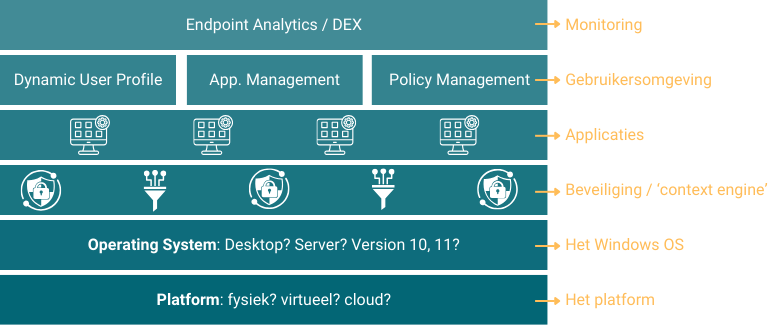FlexApp
Application Management
Modern application management
“One size doesn’t fit all” when it comes to application management on the modern workspace. Hybrid scenarios, the many migrations and even day-to-day management require multiple solutions and cost too much time and money. Moreover, organizations using Microsoft’s App-V have to look for alternative ways of application delivery anyway. With FlexApp, Liquidware offers an efficient and future-proof solution for modern application management.
About FlexApp
With a platform-agnostic approach in mind, Liquidware developed its application layering solution FlexApp. Packaged in FlexApp, applications are decoupled from the OS and placed in their own “layer”. Now they can be easily and flexibly deployed to any platform (physical, virtual, cloud). Multiple Windows versions, hybrid environments or multiple application versions that need to run side by side, are not a problem. Because applications “live” in their own layer, administrators can easily update the applications and assign them to users without having to change base images. The respective applications then display and behave as if they were traditionally installed, without contaminating the operating system.
Some of the benefits
-
Up to 50% less cost for application delivery
-
Improved security and compliance through rapid updates
-
Simple, efficient and flexible application deployment
-
Offline access to applications for remote work
-
Increased productivity and a better user experience
-
Fewer compatibility issues
-
Migrations and OS updates are simplified

Whitepaper: "Considerations for a Future-Proof Application Management Strategy"
In this whitepaper, we provide an overview of how application management has evolved to this day, including the limitations with regards to application delivery on the modern workspace. We provide insight in how application layering can help future-proofing your digital workspace.
App-V end-of-life
In 2015, the most recent version of Microsoft’s application virtualization and delivery solution App-V was released, after which active development stopped. Currently, App-V is in “extended support” until May 2026. Microsoft is working on a successor called MSIX. Currently, MSIX does not yet offer all the functionality and compatibility that was available in App-V (for example: the success rate of packaging without additional tooling, is around 40%). As a result, more and more organizations are looking at alternative strategies for their application delivery and management.
FlexApp offers this future-proof alternative and is ideally suited for hybrid workplace environments.
Direct conversion
To make the transition as smooth as possible, preserve previous investments, as well as taking future developments into account, Liquidware offers the possibility to convert App-V packages directly to FlexApp. Even if an organization wants to migrate its workstation in the future, FlexApp and associated packages remain usable. FlexApp integrates seamlessly with all leading (physical/virtual/cloud) workstations and solutions such as Intune.
See how it works?
We’d love to show you how FlexApp works in practice or to think along about your Application Management strategy Just leave your contact details and we will come back to you a.s.a.p.!
